Welcome to Yucca Valley, a hub for some of the most fascinating bird species on the planet! Here, you can find a wide variety of birds, from the tiny hummingbird to the majestic bald eagle.
Whether you are an experienced birder or just curious to learn more about these amazing creatures, Yucca Valley is the perfect place to explore.
From the desert scrub to the lush forests, you’ll find a variety of habitats in which to observe and learn about the birds of Yucca Valley.
With its abundant wildlife, stunning landscapes, and year-round sunshine, Yucca Valley is an ideal destination for birdwatchers of all experience levels.
1. Red-Tailed Hawk
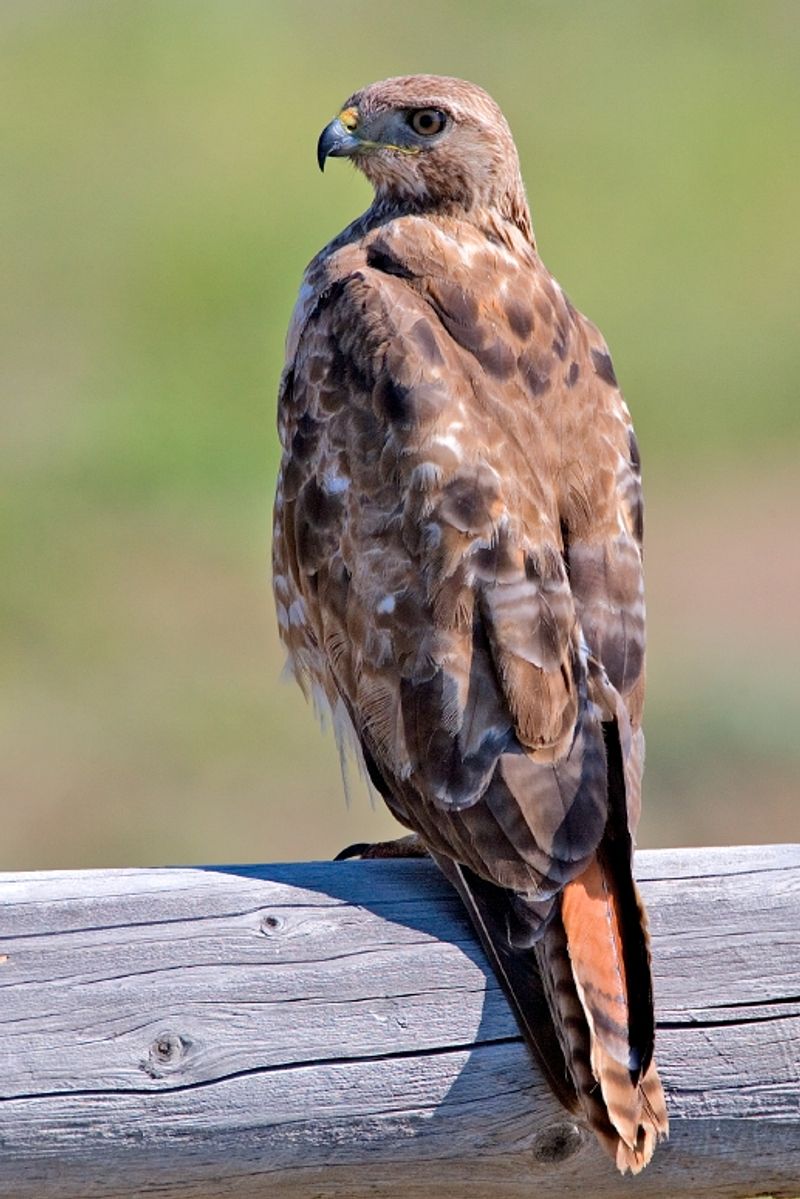
The red-tailed hawk is a bird of prey native to North America. It has a wide range, ranging from Alaska and northern Canada to as far south as Panama and the West Indies. This species is part of the genus Buteo and is one of the most common birds of prey in its range.
The red-tailed hawk is a large bird, with a wingspan of up to four feet. It is predominantly brown in color, with a distinctive reddish-brown tail. Its diet consists mainly of small mammals, such as rodents, and occasionally birds and reptiles.
It is a territorial species, often defending its nest from other predators. Red-tailed hawks are monogamous, usually forming a pair bond that lasts for life. These birds are important predators in their habitats, maintaining the balance of the ecosystem.
| Kingdom | Animalia |
| Phylum | Chordata |
| Class | Aves |
| Order | Accipitriformes |
| Family | Accipitridae |
| Genus | Buteo |
| Species | B. jamaicensis |
2. Cactus Wren
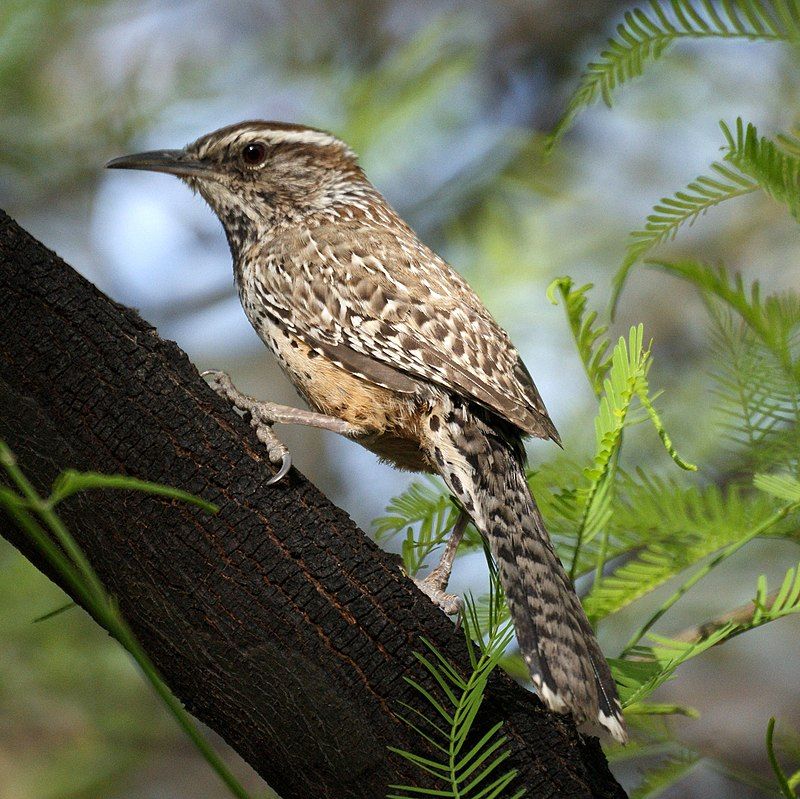
The cactus wren is a unique species of wren that is only found in the deserts of the southwestern United States and northern and central Mexico. This bird is so special that it is even the state bird of Arizona.
It is also the largest wren in the United States, making it a really impressive bird. The plumage of the cactus wren is mainly brown, with black and white spots as markings.
This helps them to blend in with the desert environment, providing them with protection from potential predators.
The cactus wren is an important species for the deserts of the southwestern United States and northern and central Mexico, and this species is a reminder of the importance of protecting these fragile ecosystems.
| Kingdom | Animalia |
| Phylum | Chordata |
| Class | Aves |
| Order | Passeriformes |
| Family | Troglodytidae |
| Genus | Campylorhynchus |
| Species | C. brunneicapillus |
3. Dark-Eyed Junco
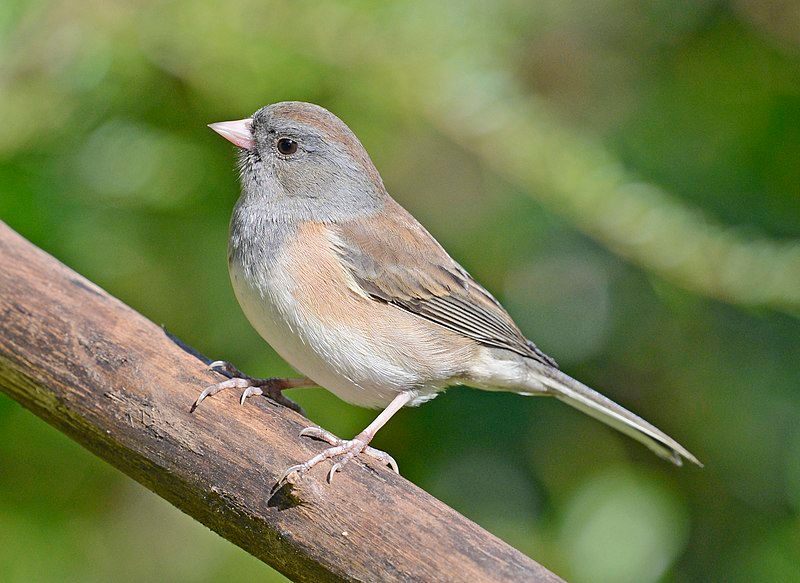
The dark-eyed junco is a species of sparrow native to the New World. It is grayish in color and relatively small compared to other birds. These birds are common across much of temperate North America and in the summer months travel far into the Arctic.
The dark-eyed junco is a very variable species, meaning its size and other physical features vary depending on the region. It is also closely related to the fox sparrow, another species of small, grayish New World sparrow.
Despite being closely related, scientists have yet to fully understand the systematics of the dark-eyed junco.
| Kingdom | Animalia |
| Phylum | Chordata |
| Class | Aves |
| Order | Passeriformes |
| Family | Passerellidae |
| Genus | Junco |
| Species | J. hyemalis |
4. Barn Owl
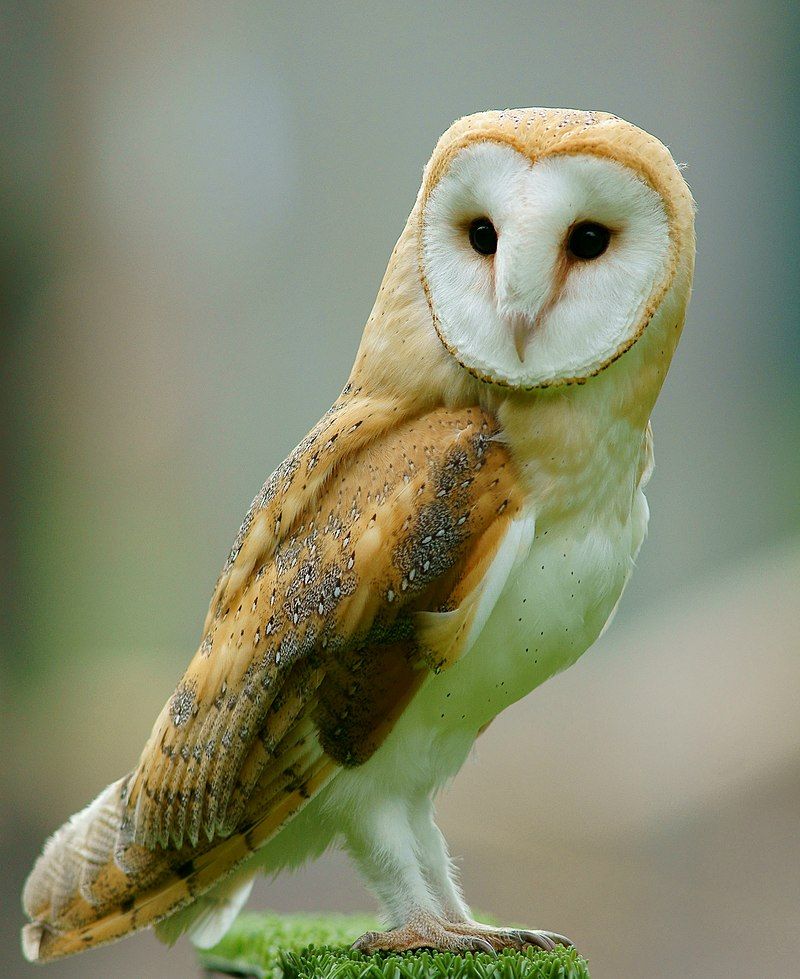
The barn owl is an incredibly adaptable species of owl, making it one of the most widely distributed species of birds around the world. It is found on every continent except for Antarctica, and in many different habitats ranging from forests to deserts.
It is even found in cities, making it one of the most common and noticeable birds. The only regions where they are not found are the polar regions, Asia north of the Himalayas, most of Indonesia, and some Pacific Islands.
This is because these regions are either too cold or too hot, or they lack the resources the barn owl needs to survive. The barn owl’s ability to survive in such a wide variety of habitats is what makes it so successful.
| Kingdom | Animalia |
| Phylum | Chordata |
| Class | Aves |
| Order | Strigiformes |
| Family | Tytonidae |
| Genus | Tyto |
| Species | T. alba |
5. Gambel’s Quail
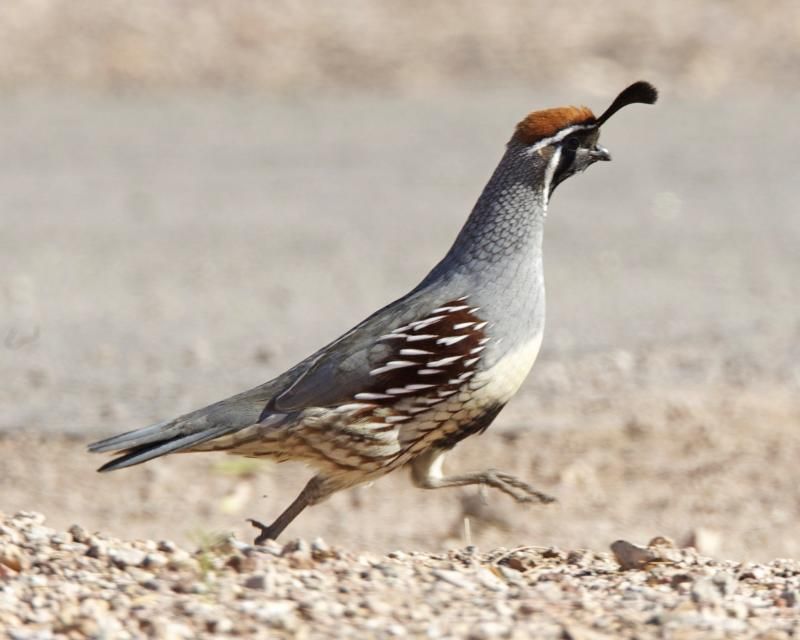
Gambel’s quail is a species of bird belonging to the New World quail family. It is a small, ground-dwelling bird which is native to the desert regions of the southwestern United States and northwestern Mexico.
Specifically, the species is found in the states of Arizona, California, Colorado, New Mexico, Nevada, Utah, Texas, and Sonora, as well as the New Mexico-border Chihuahua and the Colorado River region of Baja California. Gambel’s quail is a hardy bird which is well-suited to its arid habitat.
It is well-camouflaged, with brown and gray feathers that blend in with the colors of the desert. It prefers to live in areas with dense shrubs and grasses, and is often seen in groups known as “coteries”.
It feeds mainly on seeds, leaves, and insects, and can be seen foraging on the ground under shrubs and other plants. Gambel’s quail is a popular game bird and is hunted by both sportsmen and subsistence hunters.
Its conservation status is listed as “Least Concern” by the International Union for Conservation of Nature, as its population is thought to remain stable.
| Kingdom | Animalia |
| Phylum | Chordata |
| Class | Aves |
| Order | Galliformes |
| Family | Odontophoridae |
| Genus | Callipepla |
| Species | C. gambelii |
6. Turkey Vulture
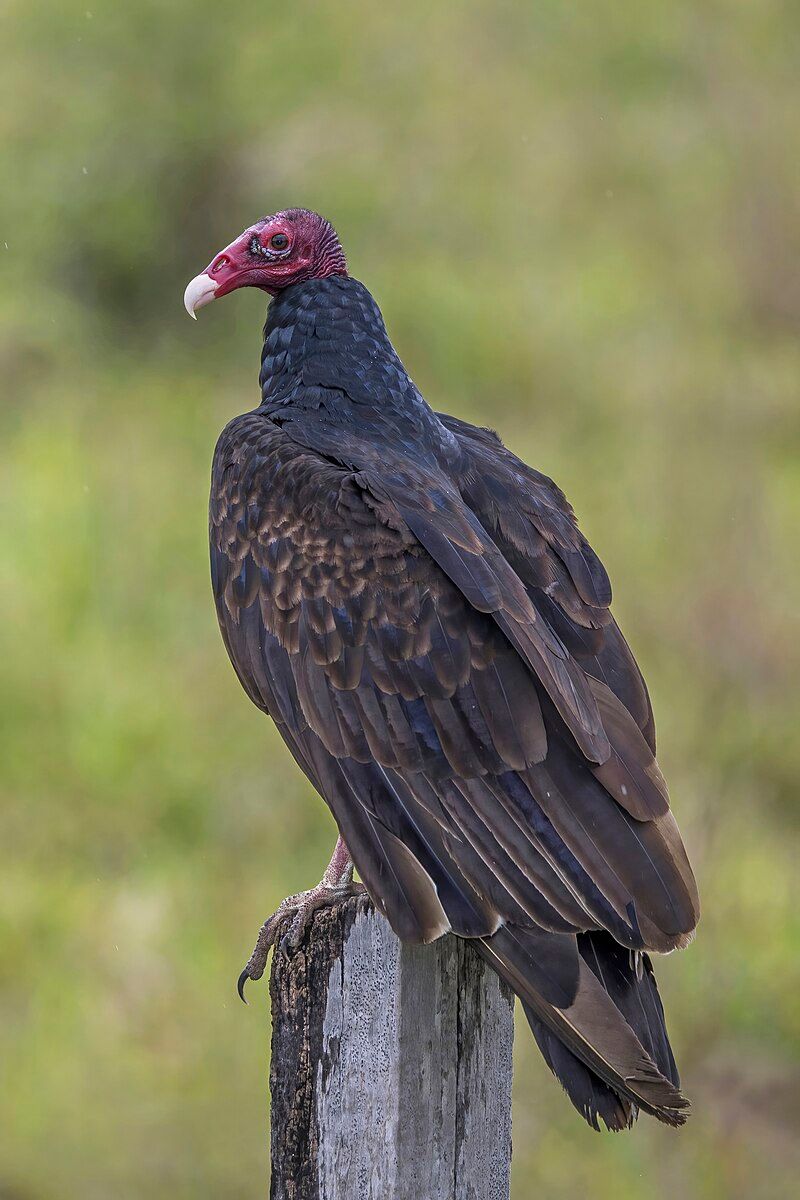
The turkey vulture is a species of New World vulture that is found all over North and South America. It is one of three species in the genus Cathartes, which is part of the family Cathartidae.
This species of vulture is particularly widespread, with its range stretching from southern Canada all the way to the southernmost tip of South America.
This large range is due to the bird’s adaptability and its ability to survive in a variety of habitats.Turkey’s vultures can be found in open fields, pastures, grasslands, deserts, and forests. It is even sometimes seen in suburban and urban areas.
This is because of its ability to feed on a wide variety of food sources, including carrion, which it locates by smell.
In addition to its broad range, the turkey vulture is also notable for its impressive wingspan, which can reach up to six feet across. The turkey vulture is a social bird and can often be seen in large groups, soaring in the sky or perched on tree branches.
This species is also known for its distinctive red head, which differentiates it from other species of vultures. These birds are beneficial to their environment, as their scavenging helps to keep it clean.
| Kingdom | Animalia |
| Phylum | Chordata |
| Class | Aves |
| Order | Accipitriformes |
| Family | Cathartidae |
| Genus | Cathartes |
| Species | C. aura |
7. Cooper’s Hawk
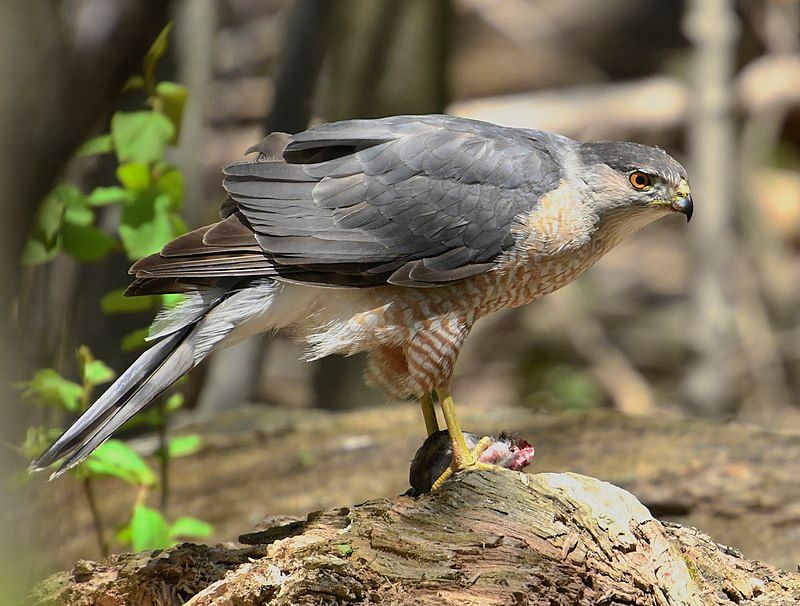
Cooper’s hawk is a species of bird found throughout the North American continent. It is a medium-sized hawk, with males typically weighing around 500 grams and females around 700 grams. This species of hawk is found in southern Canada, ranging to Mexico in the south.
It can be found in a variety of habitats, including open woodlands, fields, and even urban areas. Cooper’s hawk is a predatory bird, feeding primarily on small birds and rodents.
This species of hawk has a distinct red-brown body, with a white chest and a grayish-brown head and tail. It has yellow eyes, a black bill, and a distinctive white eye stripe.
They are also known to be very agile flyers, capable of making sharp turns and quick dives to catch their prey.
| Kingdom | Animalia |
| Phylum | Chordata |
| Class | Aves |
| Order | Accipitriformes |
| Family | Accipitridae |
| Genus | Accipiter |
| Species | A. cooperii |
8. Greater Roadrunner

The greater roadrunner is a bird belonging to the Cuculidae family which is found in the Aridoamerica region of the Southwestern United States and Mexico. Its scientific name, Geococcyx californianus, literally means “Californian earth-cuckoo”.
It is one of two species that make up the genus Geococcyx, the other being the lesser roadrunner. The greater roadrunner is a distinctive bird, easily recognizable due to its long legs and its coloration, which is a mixture of brown, tan, and black.
It has a long tail with white barring on the feathers and a white stripe on the forehead.
Its beak is long and straight and its eyes are yellow. The greater roadrunner inhabits dry, arid regions and is an omnivore, meaning it feeds on a variety of foods, such as small animals, insects, fruits, and seeds.
It is also a ground forager, meaning that it looks for and collects its food on the ground. The greater roadrunner is highly adapted to its environment, able to survive in extreme temperatures, and is a strong and fast runner.
It can even fly when necessary, although it usually prefers to stay on the ground. The greater roadrunner is also able to climb and is an excellent swimmer.
The greater roadrunner is an important part of the Aridoamerica region’s ecosystem, helping to control the population of small animals and insects. It is also an important part of the local culture in this region, being mentioned in folklore and appearing in artwork.
| Kingdom | Animalia |
| Phylum | Chordata |
| Class | Aves |
| Order | Cuculiformes |
| Family | Cuculidae |
| Genus | Geococcyx |
| Species | G. californianus |
9. White-Winged Dove
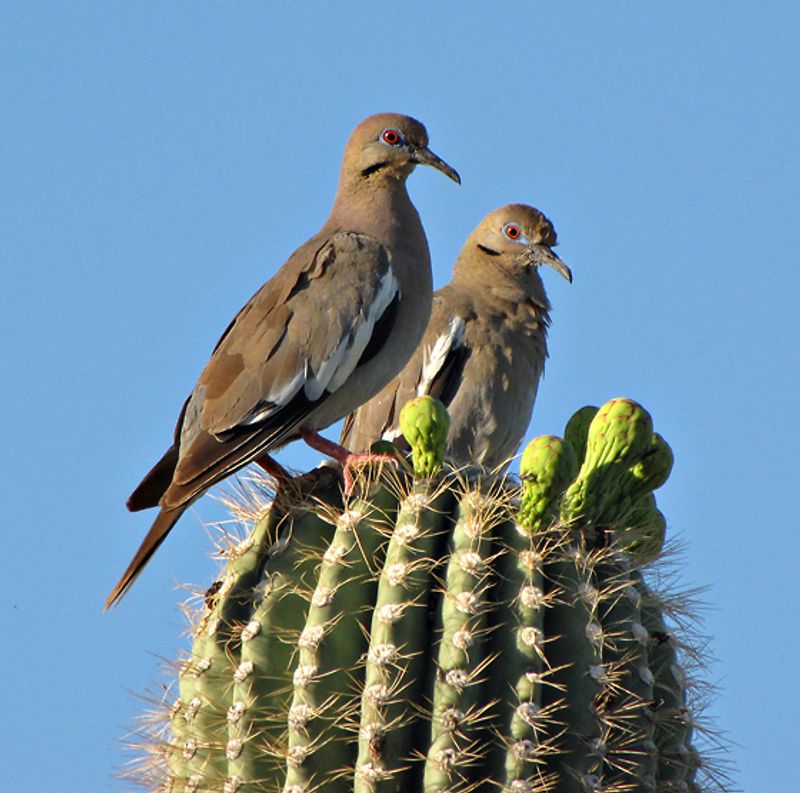
The white-winged dove is a large species of dove that is native to the Southwestern United States, Mexico, Central America, and the Caribbean. It can easily be identified by its white wing feathers, which form a distinctive white edge along the wings.
This dove also has a blue eyering surrounding its red eyes, adding to its distinct features. White-winged doves live in open woodlands, savannas, and grasslands, and they feed on seeds and grains.
They are more active in the mornings and evenings, but can often be seen in flight during the day. Because of their size and ease of identification, the white-winged dove is a popular bird among bird watchers.
These birds are also known to form flocks, and they often nest in trees and shrubs. They are known to lay two to three eggs at a time, which are a creamy white color. The female incubates the eggs for about two weeks, while the male helps her by bringing food.
Both the male and female take part in raising the young. The white-winged dove is an important species, and it is important to protect their habitats and ensure that their populations remain healthy.
Conservation efforts, such as eliminating the use of pesticides and protecting natural habitats, are essential for the survival of this species.
| Kingdom | Animalia |
| Phylum | Chordata |
| Class | Aves |
| Order | Columbiformes |
| Family | Columbidae |
| Genus | Zenaida |
| Species | Z. asiatica |
10. Mourning Dove
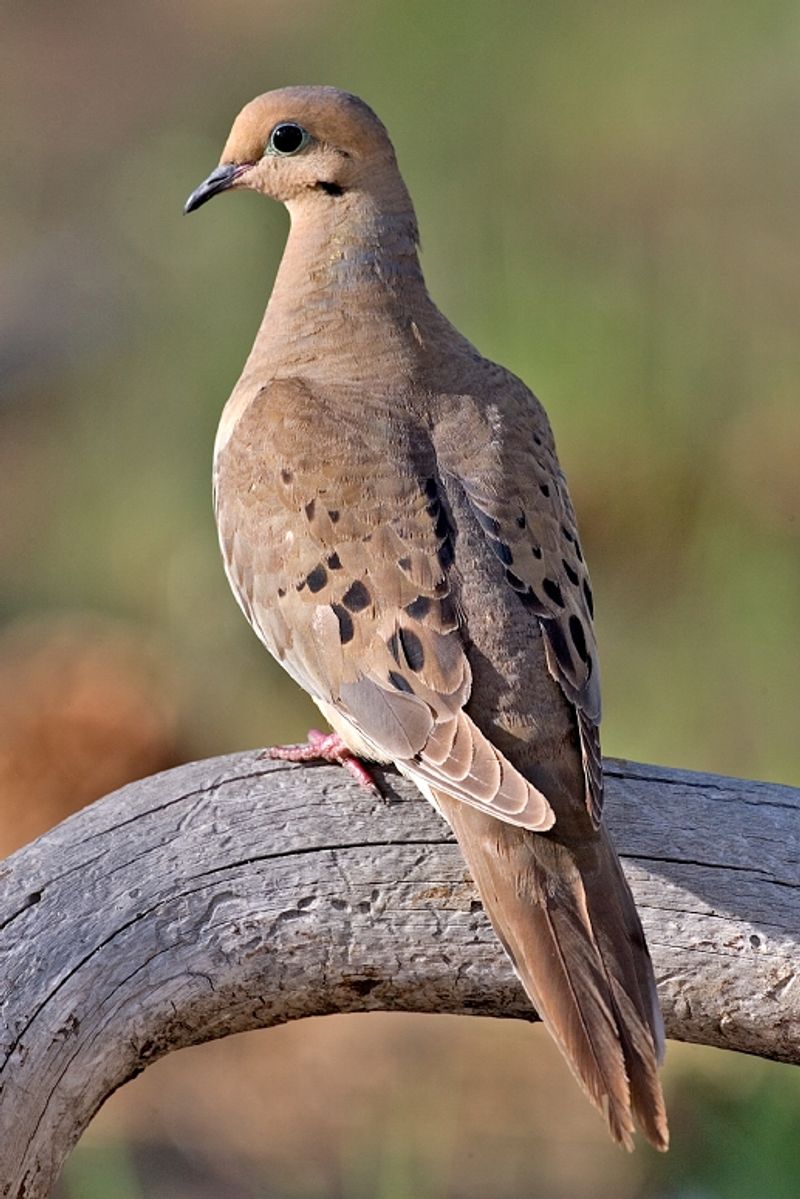
The mourning dove is a species of dove found across the Americas. It is a member of the dove family, Columbidae, and is also known by many other names, such as the American mourning dove, the rain dove, and colloquially as the turtle dove.
In the past, it was also referred to as the Carolina pigeon and Carolina turtledove. The mourning dove is a medium-sized bird, typically with grayish-brown plumage. It has a white-tipped tail and a black bill and feet.
It is commonly seen in both rural and urban areas, foraging on the ground for seeds and other small food items, and is known for its distinctive “coo-coo” call. Mourning doves are also quite adept at flying and can reach speeds of up to 55 miles per hour.
They are monogamous birds, mating for life and nesting in trees and shrubs. The female lays two white eggs, which hatch after an incubation period of two weeks. The mourning dove is a relatively common bird in its range, and its population is considered to be stable.
| Kingdom | Animalia |
| Phylum | Chordata |
| Class | Aves |
| Order | Columbiformes |
| Family | Columbidae |
| Genus | Zenaida |
| Species | Z. macroura |
11. Rock Pigeon
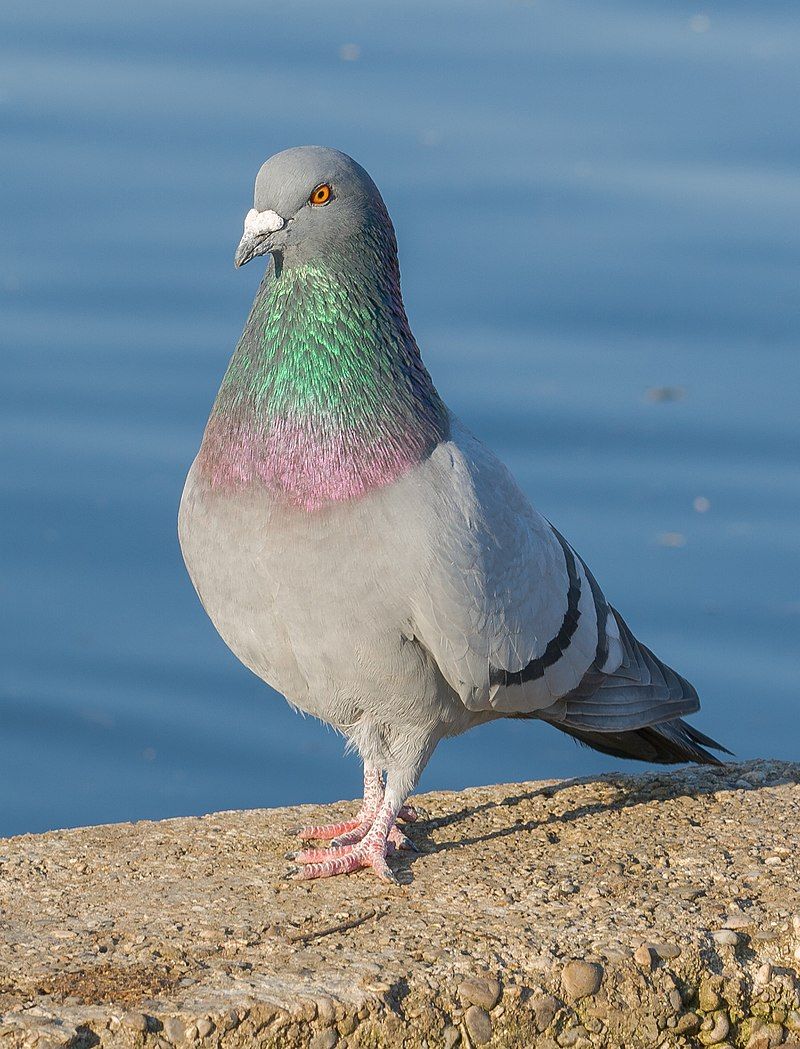
The rock dove, also known as the rock pigeon or common pigeon, is a species of bird belonging to the Columbidae family. It is commonly referred to as the “pigeon” in everyday language.
This species of bird is the ancestor of the domestic pigeon, which is a type of pigeon that is kept as a pet or used for various purposes.
Over time, some domestic pigeons have escaped and established themselves in the wild, leading to a widespread increase in the population of feral pigeons around the world. These feral pigeons are descendants of rock doves and can be found in many urban and rural areas.
The presence of these feral pigeons has enabled the species to successfully spread across the globe.
| Kingdom | Animalia |
| Phylum | Chordata |
| Class | Aves |
| Order | Columbiformes |
| Family | Columbidae |
| Genus | Columba |
| Species | C. livia |
12. Sharp-Shinned Hawk
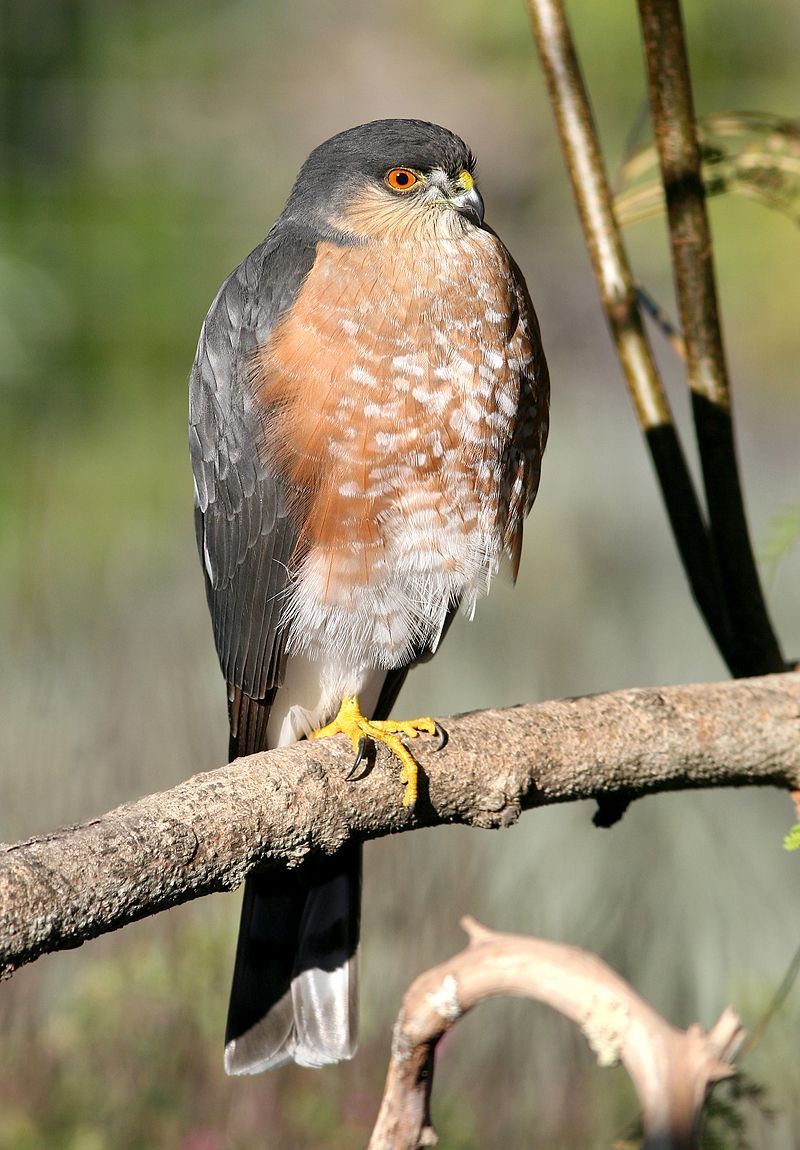
The sharp-shinned hawk, also known as a sharpie, is a small bird of prey found in the United States and Canada. Males of the species are the smallest hawks in North America, averaging smaller in size than many species of the Neotropics, such as the tiny hawk.
Despite its small size, the sharp-shinned hawk is a formidable hunter, capable of capturing and consuming a variety of prey, including small birds and mammals.
Its scientific name, Accipiter striatus, is derived from Latin, with accipiter meaning “to seize” and striatus meaning “streaked.” The sharp-shinned hawk has a slender body and a long, narrow tail, with distinctive plumage patterns of white, grey, and brown.
Its diet consists mainly of small birds, such as sparrows, juncos, and doves, but it also feeds on small mammals and insects. It is found in a variety of habitats, including open woodlands, forests, and wetlands.
The sharp-shinned hawk is an important part of the North American ecology, providing control of the populations of small birds and mammals.
| Kingdom | Animalia |
| Phylum | Chordata |
| Class | Aves |
| Order | Accipitriformes |
| Family | Accipitridae |
| Genus | Accipiter |
| Species | A. striatus |
13. Yellow-Rumped Warbler
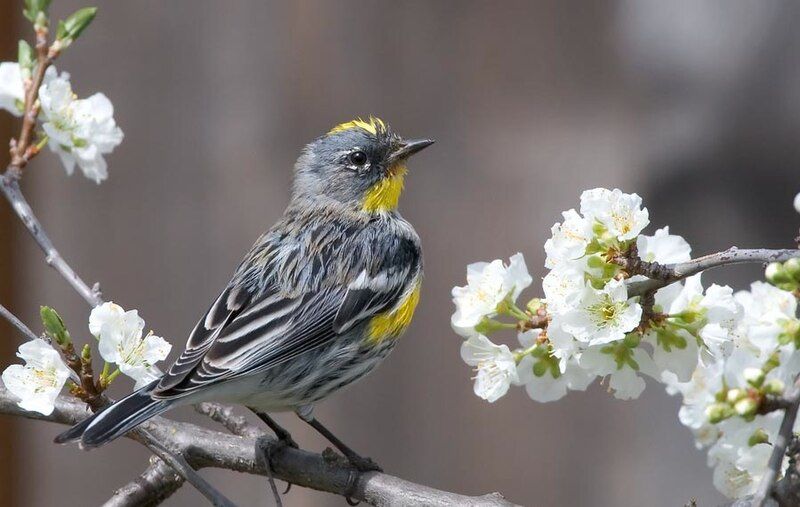
The yellow-rumped warbler is a species of bird found in North America. It is a regular visitor to the continent and can be seen in many different habitats. This species is often seen in wooded areas and is known for its distinctive yellow patch on its back.
It is a small bird, with a grey body and white throat, and a yellow patch near the tail. It feeds mainly on insects and is usually found in flocks.
It is a migratory species and can be seen migrating through the continent from southern parts of the United States to northern areas of Canada in the summer and fall months.
The yellow-rumped warbler can also be seen during the winter months in the southern United States and Mexico. This species is an important part of the North American bird population and is widely appreciated for its beauty and its adaptability.
| Kingdom | Animalia |
| Phylum | Chordata |
| Class | Aves |
| Order | Passeriformes |
| Family | Parulidae |
| Genus | Setophaga |
| Species | S. coronata |
14. Western Tanager
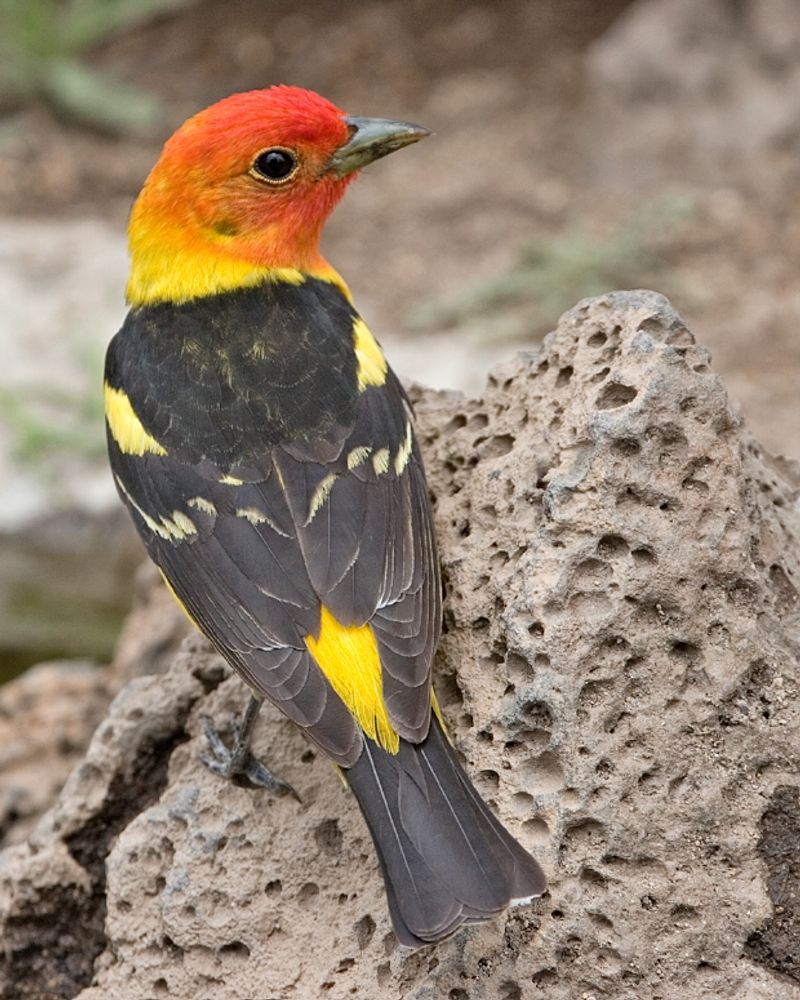
The western tanager is a medium-sized American songbird that used to be classified in the tanager family. However, current scientific classification puts it and other members of its genus in the cardinal family.
This is due to the similarities between the western tanager and other members of the cardinal family, such as its plumage and vocalizations. The plumage of the western tanager is mostly yellow and black, similar to the other members of the cardinal family.
Additionally, its vocalizations are also quite similar, making it easier to distinguish from other species of birds. Therefore, the western tanager’s similarities to the cardinal family make it easier to classify and identify.
| Kingdom | Animalia |
| Phylum | Chordata |
| Class | Aves |
| Order | Passeriformes |
| Family | Cardinalidae |
| Genus | Piranga |
| Species | P. ludoviciana |
15. Killdeer
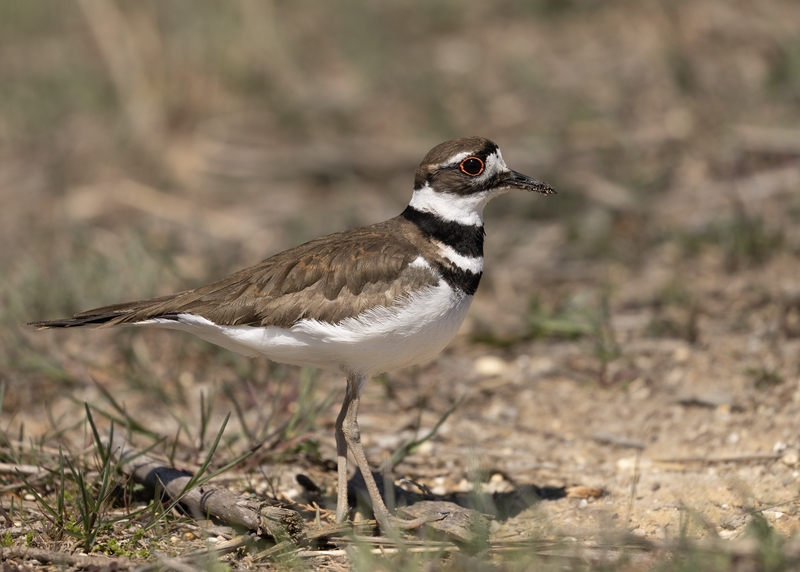
The Killdeer is a large plover found in the Americas. It is a species of wading bird and is named after its distinctive call which is a two-syllable ‘kill-deer’ sound. This species was first described in 1758 by Swedish naturalist Carl Linnaeus in his book Systema Naturae.
Today, three subspecies of the killdeer have been identified. These subspecies are based on features such as size, color, and geographical distribution.
The Killdeer is a widespread species and can be found in a variety of habitats, including open fields, grasslands, and wetlands. They are commonly seen in urban areas too, where they are often seen perched on rooftops and telephone wires.
Killdeers are omnivores, meaning they feed on both animal and plant matter. They typically hunt for small insects, worms, and crustaceans, but they are also known to feed on berries and seeds.
The Killdeer is an important species in its range, as it helps to keep insect populations in check.
| Kingdom | Animalia |
| Phylum | Chordata |
| Class | Aves |
| Order | Charadriiformes |
| Family | Charadriidae |
| Genus | Charadrius |
| Species | C. vociferus |
16. Costa’s Hummingbird
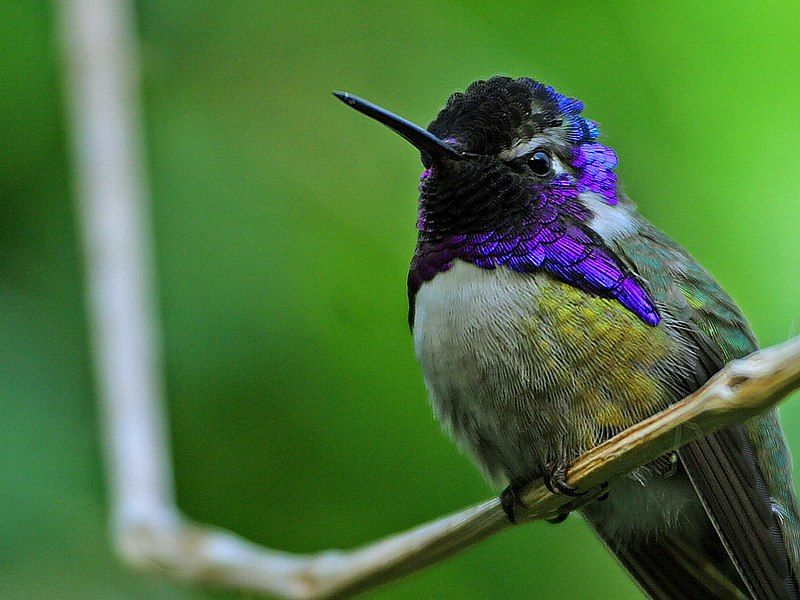
Costa’s hummingbird is a species of bird within the Trochilidae family. This bird breeds in a very specific environment: the dry, arid region of the southwestern United States and northwestern Mexico.
However, the Costa hummingbird is not a year-round resident in this particular region; instead, it migrates to western Mexico during the winter months.
This species is able to survive in such a dry climate because of its ability to consume great amounts of nectar from flowers, as well as its habit of drinking water from wet mud.
The Costa’s hummingbird is a remarkable creature that has adapted to its environment and has been able to survive in such a harsh climate.
| Kingdom | Animalia |
| Phylum | Chordata |
| Class | Aves |
| Clade | Strisores |
| Order | Apodiformes |
| Family | Trochilidae |
| Genus | Calypte |
| Species | C. costae |
17. Band-Tailed Pigeon
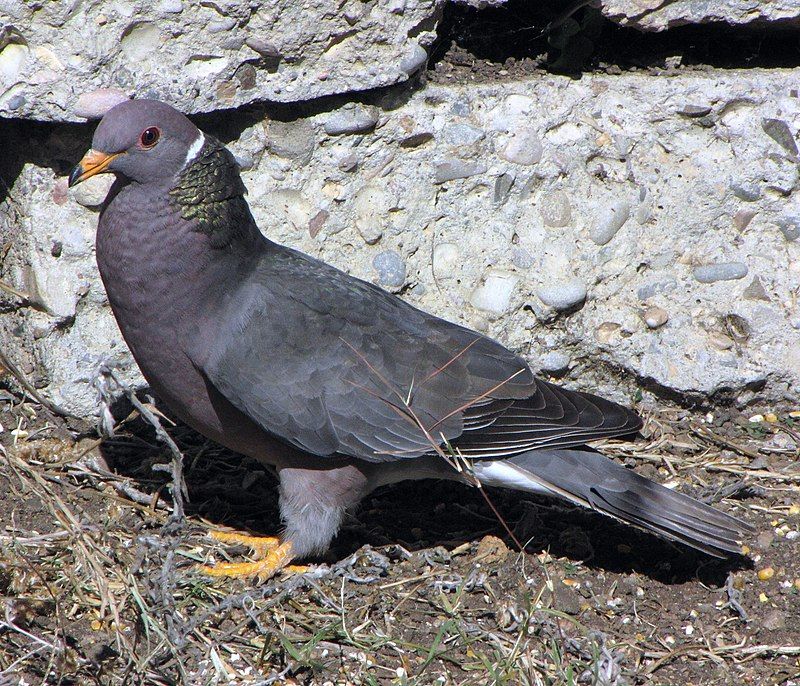
The band-tailed pigeon is a member of the Patagioenas family of birds and is native to the Americas. It has a unique identifying feature of a terminal tail band, which is a dark band at the end of its tail. This species has an overall medium-sized body size.
Furthermore, its plumage, or feathers, have a special iridescent sheen on their necks. The closest relatives of the band-tailed pigeon are the Chilean pigeon and the ring-tailed pigeon. All three species form a clade, which is a group of organisms that share a common ancestor.
This clade is characterized by having a terminal tail band and iridescent plumage on its necks. The band-tailed pigeon has adapted to many different habitats, including mountain forests, woodlands, and coastal areas.
It is found in parts of North America, Mexico, Central America, and South America. The pigeon has a varied diet, consisting of nuts, berries, and other fruit.
It has even been known to eat insects and small invertebrates. The band-tailed pigeon is an interesting medium-sized bird of the Americas.
It is closely related to the Chilean and ring-tailed pigeons, forming a clade of Patagioenas with a terminal tail band and iridescent plumage on their necks. This species is able to survive in a variety of habitats and has a varied diet.
| Kingdom | Animalia |
| Phylum | Chordata |
| Class | Aves |
| Order | Columbiformes |
| Family | Columbidae |
| Genus | Patagioenas |
| Species | P. fasciata |
18. Bald Eagle
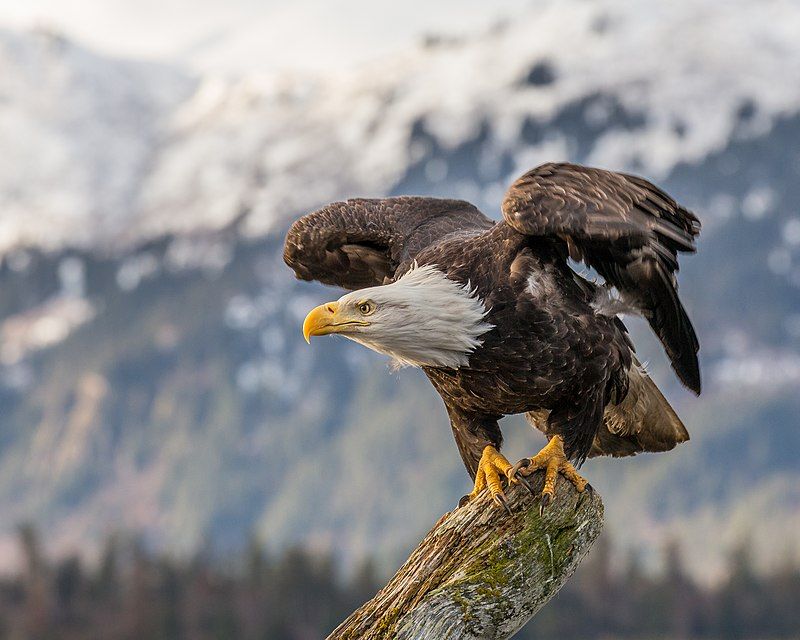
The bald eagle is a large bird of prey native to North America and is easily recognizable due to its distinctive white head and dark brown body. It is a sea eagle, meaning it hunts for food near the ocean or large bodies of water.
The bald eagle has two known subspecies, which are distinguished by slight differences in their physical characteristics. The bald eagle is closely related to the white-tailed eagle, which is found in the Palearctic region, and the two species share many similarities.
Both species occupy the same niche, meaning they feed on the same types of prey and inhabit similar habitats. The bald eagle is a powerful bird of prey and is a symbol of strength and freedom in the United States.
| Kingdom | Animalia |
| Phylum | Chordata |
| Class | Aves |
| Order | Accipitriformes |
| Family | Accipitridae |
| Genus | Haliaeetus |
| Species | H. leucocephalus |
19. White-Crowned Sparrow
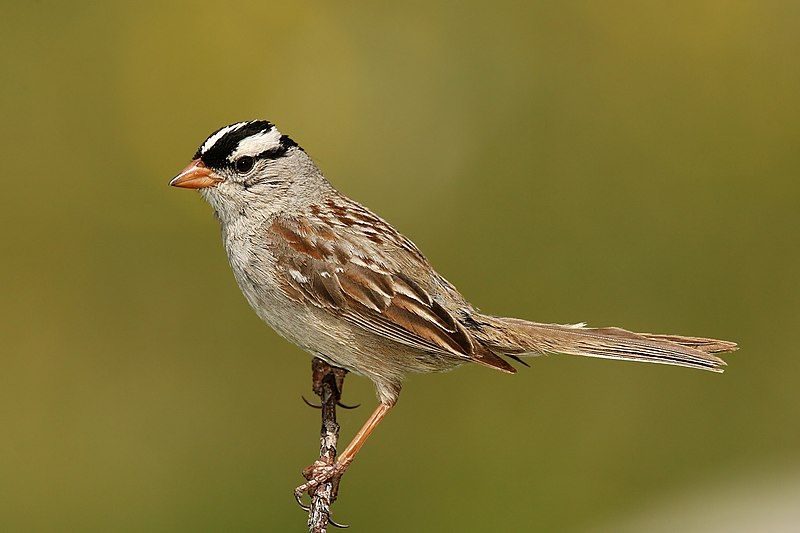
The white-crowned sparrow is a small songbird found in North America. It is a member of the New World sparrow family and is recognizable by its grey face and the black and white stripes on its head.
It is a medium-sized bird, with a wingspan of 7.5 to 9.5 inches, and a body length of 5 to 6.5 inches. Its upperparts are light brown, with darker streaks and its underparts are pale gray.
The white-crowned sparrow has a distinctive black stripe that runs from its bill to the back of its head and a white crown with black and grey stripes. The white-crowned sparrow prefers habitats with dense vegetation, such as chaparral, sagebrush, and woodland edges.
It is mainly a seed-eater, but also feeds on insects and berries. In the winter, it migrates south and can be found in the western United States and Mexico. The white-crowned sparrow is a fairly common species, and its population is stable.
| Kingdom | Animalia |
| Phylum | Chordata |
| Class | Aves |
| Order | Passeriformes |
| Family | Passerellidae |
| Genus | Zonotrichia |
| Species | Z. leucophrys |
20. Shrikes
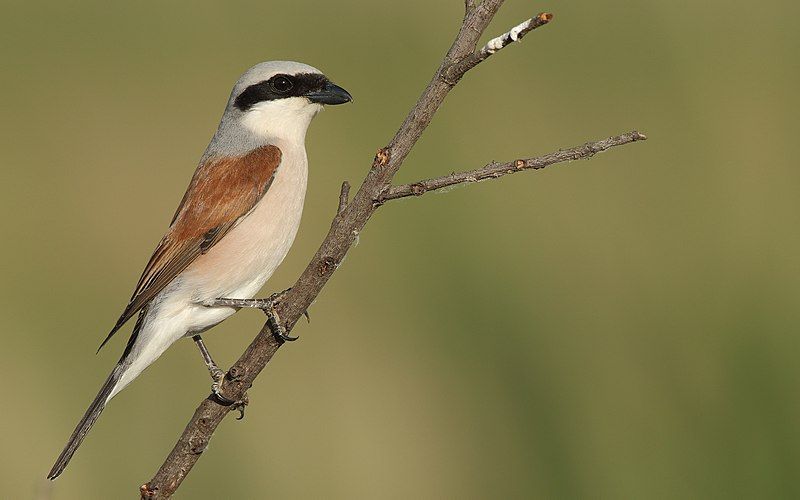
Shrikes are small, perching birds in the family Laniidae. These birds are found in various parts of the world and are known for their impressive hunting skills. They have a distinctive hooked bill and a grayish-brown coloration with black and white markings.
The family Laniidae is made up of 34 species, split between two genera. These genera are Lanius and Eurocephalus, which can be divided further into subgenera and species.
Some of the more common species of shrike include the Northern Shrike, Loggerhead Shrike, and the Isabelline Shrike. Each species is adapted to its own habitat and has its own unique set of behaviors.
For example, the Loggerhead Shrike hunts by perching on a tree branch and waiting for prey to come within reach, while the Isabelline Shrike hunts by hovering in midair.
The various species of shrike exhibit different levels of aggression and territoriality, but all are fiercely protective of their nests and young.
| Kingdom | Animalia |
| Phylum | Chordata |
| Class | Aves |
| Order | Passeriformes |
| Family | Laniidae |
21. Double-Crested Cormorant
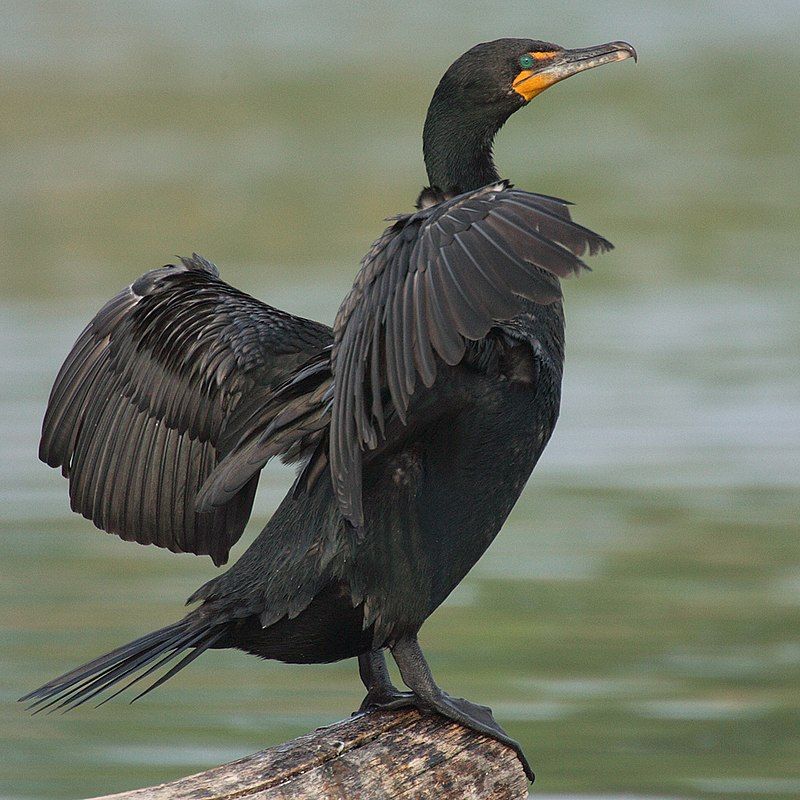
The Double-Crested Cormorant is a type of water bird belonging to the Cormorant family. It is mainly found in North America, living near rivers, lakes, and coastal areas.
This bird species ranges all the way from the Aleutian Islands in Alaska down to Florida and Mexico, making it one of the most widely distributed birds on the continent.
They are a common sight in many areas and can be seen flying around or perched in trees that are near bodies of water. Double-Crested Cormorants have long, slender bodies and webbed feet, which help them to swim and dive underwater in search of food.
They mainly feed on small fish, frogs, and other aquatic creatures. The birds have a wide wingspan, and they use their wings to glide in the air in search of prey.
They also have a dark-colored plumage that helps them blend in with their surroundings. The Double-Crested Cormorant is an interesting bird species, and they can be quite entertaining to watch.
They are an important part of the North American ecosystem, and it is important to protect and preserve their habitats for future generations.
| Kingdom | Animalia |
| Phylum | Chordata |
| Class | Aves |
| Order | Suliformes |
| Family | Phalacrocoracidae |
| Genus | Nannopterum |
| Species | N. auritum |
22. Long-Eared Owl
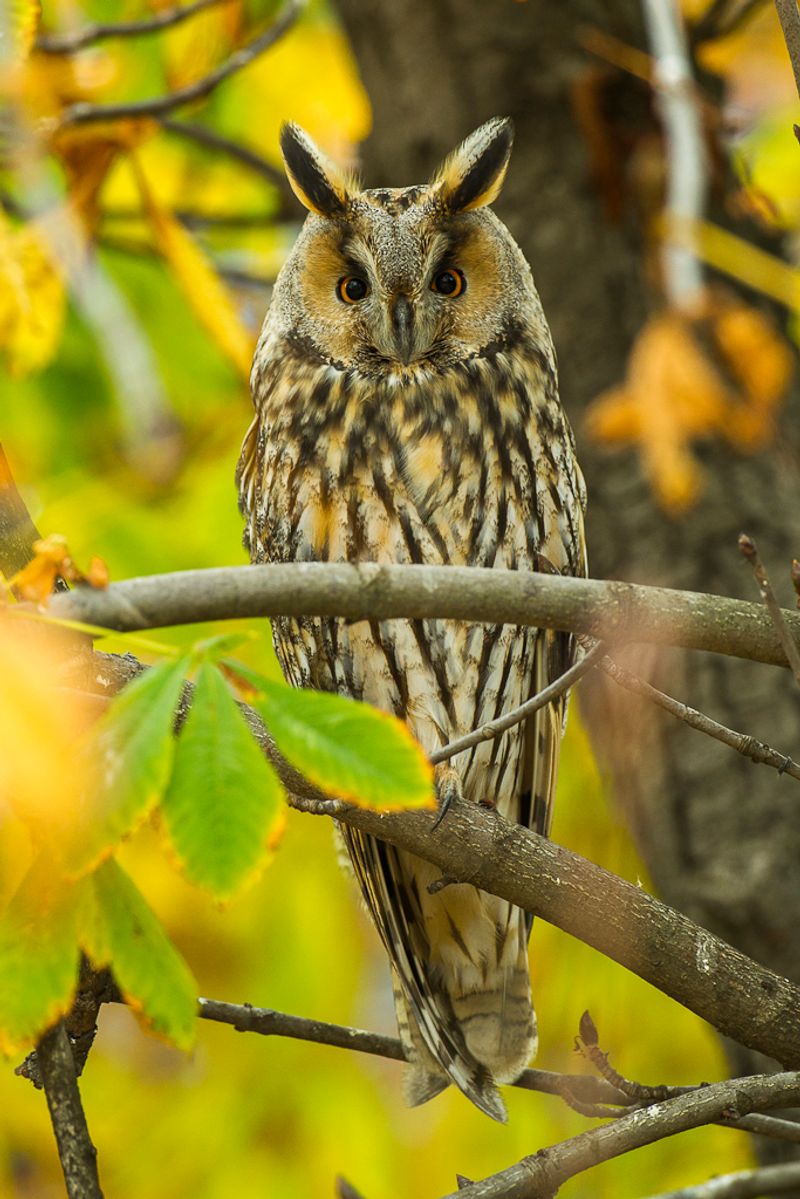
The long-eared owl is a medium-sized species of owl that is found in a wide range of habitats. Its scientific name is derived from Latin: Asio is a type of eared owl and otus also refers to a small, eared owl.
The long-eared owl is also known by other names such as the northern long-eared owl, the lesser horned owl, and the cat owl. Its habitats include deciduous and coniferous forests, wooded grasslands, and shrublands.
It prefers to breed in forests with large trees that provide adequate nesting sites. The long-eared owl is a nocturnal species and hunts small mammals, birds, and insects. It is a solitary hunter and is most active at dawn and dusk.
It is relatively common in much of its range and is listed as a species of least concern by the IUCN.
| Kingdom | Animalia |
| Phylum | Chordata |
| Class | Aves |
| Order | Strigiformes |
| Family | Strigidae |
| Genus | Asio |
| Species | A. otus |
23. Belted Kingfisher
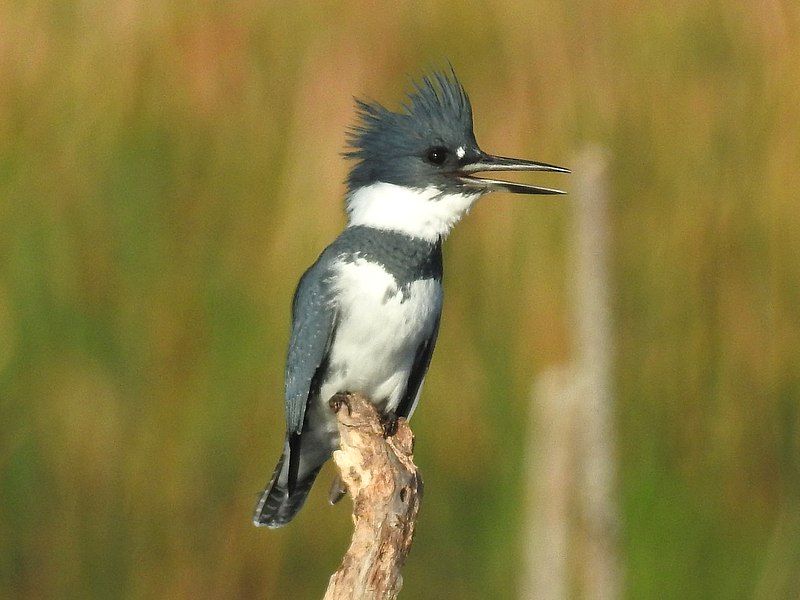
The Belted Kingfisher is a large, brightly colored bird found in North America. It belongs to the family of birds known as Alcedinidae, which includes all Kingfishers. Recent research, however, suggests that Alcedinidae should be split into three distinct subfamilies.
This is due to the fact that Kingfishers have evolved over time and can no longer be classified under the same umbrella. For example, some Kingfishers are smaller and have different physical characteristics than others.
Additionally, some Kingfishers have adapted to different environments and climates. Splitting the family into three subfamilies will help to better classify the species and give a clearer understanding of how they have evolved over time.
| Kingdom | Animalia |
| Phylum | Chordata |
| Class | Aves |
| Order | Coraciiformes |
| Family | Alcedinidae |
| Genus | Megaceryle |
| Species | M. alcyon |
24. Loggerhead Shrike
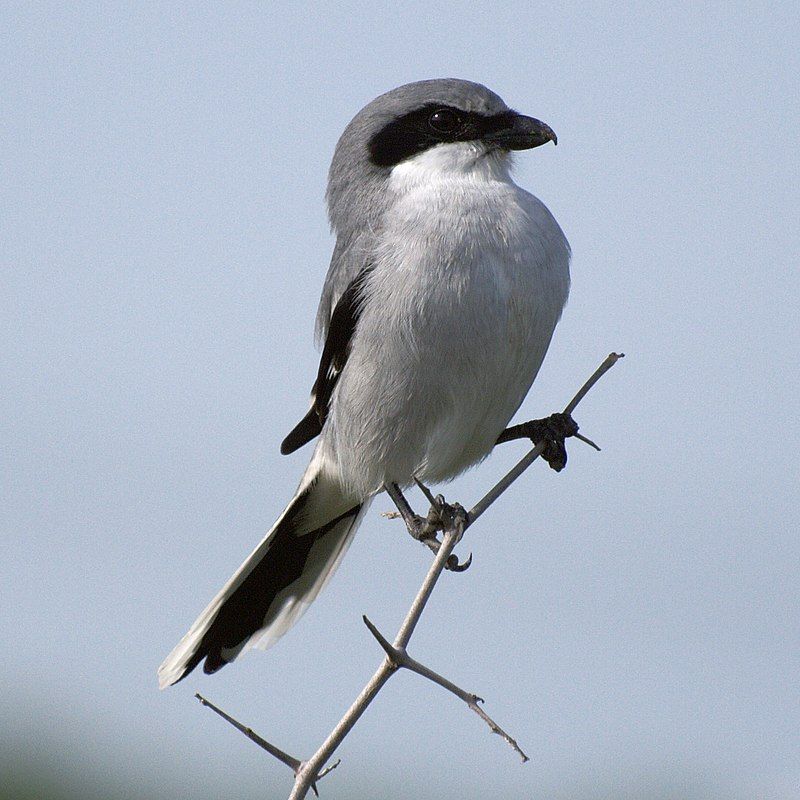
The loggerhead shrike is a type of songbird that belongs to the family Laniidae. It is the only shrike species that is native to North America.
The northern shrike is related to the loggerhead shrike, but it is found in areas north of the range of the loggerhead shrike, including Siberia.
The northern shrike and the loggerhead shrike are similar in size, shape, and behavior, but they differ in the location of their habitats.
The loggerhead shrike is found in open woodlands, grasslands, and agricultural areas, while the northern shrike prefers boreal and tundra habitats. Both species have distinctive black and white plumage, a hooked bill, and a sharp, pointed tail.
They are also known for their behavior of impaling their prey on thorns and barbed wire. In addition, they use their strong bill to make prey easier to eat by crushing bones.
The loggerhead shrike and the northern shrike are both important predators of small mammals, birds, lizards, and insects.
| Kingdom | Animalia |
| Phylum | Chordata |
| Class | Aves |
| Order | Passeriformes |
| Family | Laniidae |
| Genus | Lanius |
| Species | L. ludovicianus |
Conclusion
Birds are an important part of the ecology of Yucca Valley. They provide food for other species, help pollinate native plants, and act as indicators of environmental health. They are also a source of joy and entertainment for residents and visitors alike.
As we continue to learn more about the birds of Yucca Valley, we can better appreciate their importance and take steps to protect and conserve them.